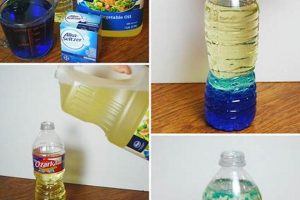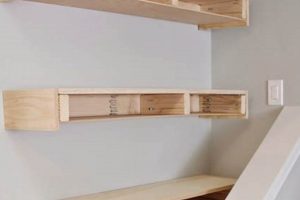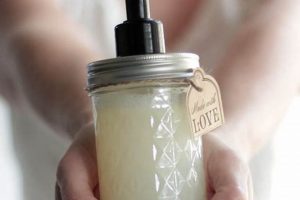Creating personalized designs on various surfaces through the application of ink or paint using a pre-cut or custom-made stamp is a popular crafting method. This technique allows for the replication of images and patterns, offering a cost-effective alternative to hand-drawing or other more complex decorative methods. For example, individuals might use this process to add unique embellishments to greeting cards, fabric items, or even home decor pieces.
The benefits of this crafting approach extend beyond mere aesthetics. It provides a relatively inexpensive and easily accessible avenue for creative expression and personalization. Historically, this method has been utilized for centuries in various cultures for purposes ranging from printing textiles to marking official documents. Its enduring appeal lies in its simplicity and the vast possibilities it offers for artistic exploration and functional application.
The following sections will delve into specific aspects of this decorative process, including the materials required, diverse application methods, and techniques for achieving professional-looking results. Guidance on selecting the appropriate supplies and troubleshooting common issues will also be provided.
Crafting Success
This section outlines crucial tips for achieving optimal results when engaging in personalized design replication. Careful attention to these guidelines will enhance the quality and longevity of finished projects.
Tip 1: Ink Selection Matters. The choice of ink should align with the substrate. Fabric projects require permanent fabric inks that withstand washing, while paper crafts benefit from acid-free inks to prevent discoloration over time. Experimentation with different ink types on scrap materials is recommended before applying to the final piece.
Tip 2: Surface Preparation is Key. Ensure the surface is clean, dry, and free of debris. Porous surfaces may require pre-treatment or priming to prevent ink bleeding. For fabric, ironing the material beforehand provides a smoother, more receptive surface.
Tip 3: Mounting for Precision. Utilize clear acrylic blocks or mounting devices to achieve accurate stamp placement. These tools allow for better visibility and control, resulting in cleaner, more defined impressions. Consider investing in a variety of block sizes to accommodate stamps of different dimensions.
Tip 4: Mastering Pressure Application. Apply even and consistent pressure when pressing the stamp onto the surface. Avoid rocking or shifting the stamp, as this can result in blurred or incomplete images. Use a firm, steady hand to distribute pressure evenly across the entire stamp.
Tip 5: Cleaning for Longevity. Clean stamps immediately after each use with an appropriate stamp cleaner. Residual ink can damage the stamp over time and compromise future impressions. Different materials require different cleaning methods; consult the manufacturer’s recommendations.
Tip 6: Storage Matters. Store stamps in a cool, dry place away from direct sunlight. Organize stamps by type or theme for easy access and to prevent damage. Clear storage containers or binders with pockets are ideal for maintaining stamp organization.
Applying these techniques will significantly improve the quality and consistency of design replication projects. Careful planning, material selection, and meticulous execution are essential for achieving professional-looking results.
The subsequent segments will discuss advanced methods and creative applications, providing further opportunities to refine and expand design replication skills.
1. Ink Selection
Ink selection is a critical component of the design replication process, directly influencing the aesthetic quality, durability, and longevity of the finished product. The characteristics of the ink must be compatible with the target surface; mismatched ink and substrate pairings inevitably lead to unsatisfactory results. For instance, using water-based ink on coated paper may cause smudging and prevent proper adhesion, while solvent-based inks may damage delicate materials like certain fabrics or thin paper stocks. The desired outcome of the replication endeavor determines the ideal ink type; permanent inks are essential for projects requiring washability or resistance to fading, whereas archival inks are necessary for preserving documents or artwork intended for long-term storage.
Consider the application of metallic inks on dark cardstock for creating elegant greeting cards. A poorly chosen ink might appear dull or uneven, negating the desired effect. Conversely, selecting a high-quality metallic pigment ink designed for use on non-porous surfaces ensures a vibrant, eye-catching impression. Similarly, in textile projects, failure to use fabric-specific inks that bond effectively with fibers will result in designs that fade or wash away after laundering. Understanding the chemical properties of different inks and their interactions with various materials is therefore paramount for achieving optimal results and avoiding costly errors.
In summary, the correlation between ink choice and the overall success of a design replication project cannot be overstated. Careful consideration of the intended application, substrate properties, and desired effect is essential. Failure to select the appropriate ink can compromise the visual appeal, durability, and long-term preservation of the finished product. Therefore, investing in quality inks and understanding their specific properties is a fundamental aspect of achieving consistently superior results in design transfer processes.
2. Surface preparation
Surface preparation is an indispensable preliminary stage within the personalized design transfer process. It directly influences the clarity, adhesion, and overall aesthetic outcome of the finished design. Insufficient or improper surface preparation can lead to blurred impressions, ink bleeding, or uneven coverage, effectively undermining the desired results. For instance, attempting to apply ink to a dusty wooden surface will likely result in a flawed image, as the dust particles interfere with ink adhesion. Similarly, fabric surfaces that have not been pre-washed and ironed may exhibit wrinkles or sizing that disrupt the design transfer process.
The specific surface preparation techniques required depend on the material being used. Porous surfaces, such as untreated wood or certain types of paper, often require a sealant or primer to prevent excessive ink absorption and bleeding. Smooth, non-porous surfaces, like glass or metal, may benefit from a light etching or cleaning with alcohol to improve ink adhesion. In textile applications, pre-washing removes sizing agents and ensures that the fabric is relaxed, preventing distortion of the applied design after subsequent laundering. Neglecting these preparatory steps can significantly reduce the durability and visual appeal of the finished project, necessitating re
work or rendering the project unusable.
In conclusion, surface preparation is not merely a preliminary step but an integral component of the overall personalized design replication workflow. Thorough and appropriate preparation is essential for achieving high-quality, lasting results. By understanding the specific requirements of different materials and employing suitable techniques, individuals can minimize the risk of errors and maximize the potential for successful creative endeavors. The commitment to proper preparation translates directly into a superior final product and reinforces the value of meticulous craftsmanship in design application.
3. Pressure control
In design transfer via stamping, pressure control directly influences the quality of the resulting image. Insufficient pressure leads to incomplete ink transfer, resulting in faint or fragmented designs. Excessive pressure, conversely, causes ink to spread beyond the intended boundaries, creating blurred or distorted impressions. Consistent pressure application is, therefore, crucial for achieving clean, well-defined images. The firmness of the substrate also plays a role; softer materials require less pressure than harder ones to achieve the same result. Consider the effect when creating greeting cards. Uneven pressure results in parts of a stamped image being missing. A steady, moderate pressure produces a uniform image.
The technique used for applying pressure also matters. Rocking or tilting the stamp during application can cause inconsistent pressure, leading to uneven ink distribution and blurred edges. Using a mounting block and applying direct, even pressure minimizes these issues. Specific stamping tools, like stamping platforms, are engineered to provide uniform pressure across the entire stamp surface. In textile design, uneven pressure during stamping can result in a design that fades unevenly after washing. Understanding pressure control as a key component of the design transfer process enhances the success and predictability of projects.
Mastering pressure control presents a tangible challenge, but the rewards are designs of superior quality. The knowledge of cause and effect and attention to surface characteristic are the key factors. Recognizing the significance of surface type and applying appropriate pressure techniques ensures a successful result. It highlights the importance of technique refinement for enhanced creative design execution.
4. Stamp cleaning
Maintaining stamp integrity through consistent and appropriate cleaning practices is paramount in ensuring the longevity and quality of outcomes in personalized design transfer projects. This process directly influences the clarity of future impressions and prevents the cross-contamination of inks, ultimately affecting the overall effectiveness of the creative endeavor.
- Prevention of Ink Build-Up
Residual ink accumulation on stamp surfaces distorts subsequent impressions. Dried ink hardens, fills fine details, and compromises accurate ink transfer. Routine cleaning after each use prevents this build-up, preserving the original design clarity. For example, neglecting to clean a detailed floral stamp used with pigment ink will quickly result in clogged grooves and less-defined floral patterns in future applications. Without proper cleaning, the stamp will lose its detail, impacting the overall project.
- Preservation of Stamp Material
Various ink types contain solvents or pigments that, if left in contact with stamp materials (rubber, silicone, photopolymer), can cause degradation over time. Solvent-based inks are particularly aggressive, potentially causing swelling, cracking, or disintegration of the stamp. Prompt and proper cleaning with appropriate cleaning solutions neutralizes these effects, extending the stamp’s lifespan. Fabric inks contain dyes and chemicals and damage if not cleaned properly. Without proper maintenance, design transfer tools will be unusable.
- Minimizing Ink Cross-Contamination
Using the same stamp with different ink colors without thorough cleaning results in unwanted color mixing and muddied impressions. Cross-contamination is especially problematic when transitioning between light and dark colors. For example, stamping a light yellow image after using a dark blue ink without cleaning will result in a greenish-tinged yellow, compromising the intended aesthetic. Maintaining separate cleaning tools and solutions for different ink types further minimizes cross-contamination risks. Without cleaning the proper tools will be wasted or damaged.
- Optimizing Ink Transfer Quality
A clean stamp surface allows for even ink distribution and optimal contact with the substrate, resulting in sharper, more consistent impressions. Debris or dried ink on the stamp can create uneven ink transfer, leading to patchy or incomplete designs. Regularly cleaning stamps ensures a smooth, contaminant-free surface, maximizing ink adhesion and image clarity. A properly cleaned stamp is essential for achieving consistent and professional results.
The correlation between consistent stamp cleaning and the overall quality of design transfers cannot be overstated. Investing in appropriate cleaning supplies and establishing a routine cleaning protocol directly contributes to the longevity of design transfer tools and improves the quality of design implementations. Ignoring this critical maintenance step ultimately undermines the effectiveness and cost-efficiency of stamping.
5. Design choice
Design choice in the context of personalized design replication dictates the visual impact and communicative effectiveness of the final product. It encompasses a range of factors influencing the selection and application of visual elements within the process.
- Motif Selection
Motif selection, the central image or pattern employed, directly establishes the thematic content and stylistic tone of the project. A floral motif evokes nature or sentimentality, while a geometric pattern suggests modernity or precision. Choosing an inappropriate motif undermines the intended message or aesthetic. Inaccurate replication causes visual disharmony.
- Font and Typography
For projects incorporating text, font choice dictates legibility and stylistic coherence. A sans-serif font conveys simplicity and clarity, whereas a serif font imparts formality and tradition. Illegible or stylistically incongruent fonts compromise the message. In the example of invitations, font impacts the overall impression.
- Color Palette
The selected color palette influences the emotional response and visual harmony of the design. Warm colors evoke energy and excitement, while cool colors create calmness and serenity. Colors need to compliment motifs and themes. Incompatible color combinations result in visual dissonance. The colors must be carefully thought out to effectively convey a message.
- Layout and Composition
Arrangement of design elements within a defined space affects balance, emphasis, and visual flow. A symmetrical layout conveys stability, while an
asymmetrical layout suggests dynamism. Poor composition leads to visual clutter. Effective designs must be balanced and engaging.
These facets underscore the significance of informed design decisions in personalized design transfer projects. Thoughtful consideration of motifs, fonts, color, and layout culminates in visually compelling and effective communications, enhancing the overall value and impact of design endeavors. Failure to recognize these components renders the process inefficient.
6. Mounting technique
Mounting technique is a pivotal element within personalized design replication. This process dictates the precision and clarity of the replicated image. The absence of a secure and properly aligned mounting system results in misaligned or incomplete image transfers, thus undermining the overall objective of the creative effort. Direct contact with a stamp lacks stability. Using a mounting block enables consistent and even transfer. Without appropriate technique, the outcome may lack clarity and precision.
Specific mounting methods vary based on stamp material and desired effect. Acrylic blocks, widely favored for clear stamps, permit precise positioning due to their transparency. Static cling mounting systems offer versatility, enabling reuse with diverse stamps. Fixed-mount stamps affixed to wooden blocks provide stability for intricate designs. In textile design, where accurate registration is critical for repeating patterns, specialized mounting jigs and frames are employed to maintain consistency and alignment throughout the project. An example of this is using a clear acrylic block to position a complex floral pattern on a cardstock, allowing for a layered design with precise alignment and preventing smudging. Incorrect methods distort the final product.
Mounting technique is a foundational aspect of the overall design transfer process. Precise alignment and stability ensure accurate image replication. Choosing the appropriate method enhances the predictability and quality of projects. Mastery of this phase promotes creative design expression, contributing to improved craft designs, and emphasizes the link between technique and output.
Frequently Asked Questions
The following section addresses common inquiries and misconceptions surrounding personalized design transfer, providing clarification on essential techniques and best practices.
Question 1: What are the primary factors influencing the quality of design transfer?
Ink selection, surface preparation, pressure control, and stamp maintenance are crucial determinants. Careful attention to these elements ensures clean, lasting impressions.
Question 2: How does ink choice impact the longevity of textile-based designs?
The use of permanent fabric inks is imperative for textile projects intended for washing. Standard inks will fade or wash away, compromising the design’s integrity.
Question 3: Why is surface preparation essential prior to applying an image?
Proper surface preparation, including cleaning and priming, promotes optimal ink adhesion and prevents bleeding, enhancing the clarity and durability of the transferred design.
Question 4: What techniques optimize pressure control during the design transfer process?
Employing a mounting block, applying even pressure, and avoiding stamp movement are essential for consistent ink distribution and preventing blurred or distorted images.
Question 5: How does routine cleaning contribute to the lifespan of stamping tools?
Regular cleaning removes ink residue, preventing material degradation and maintaining design clarity. Consistent maintenance maximizes tool lifespan and preserves impression quality.
Question 6: What role does design choice play in overall effectiveness of stamping design?
Design dictates message and visual harmony, impacting communicative effectiveness. Choosing the right motifs, color, font, and composition is essential to maximize visual communication.
Careful attention to these FAQs promotes greater command of design replication projects.
The following segments will provide further advice for improving design transfer strategies.
Stamping DIY
This exploration has underscored the critical elements governing successful personalized design transfer. From meticulous ink selection and surface preparation to precise pressure control and consistent tool maintenance, each stage significantly influences the quality and longevity of the final product. The informed selection of design elements, encompassing motifs, fonts, color palettes, and layout composition, further determines the visual impact and communicative efficacy of the design.
Mastery of design transfer requires diligence and an understanding of the interplay between materials, techniques, and aesthetic considerations. The potential for creative expression through the design process remains extensive. Continued refinement of these skills and the exploration of innovative applications promise further advancements in the art of personalized design implementation.







